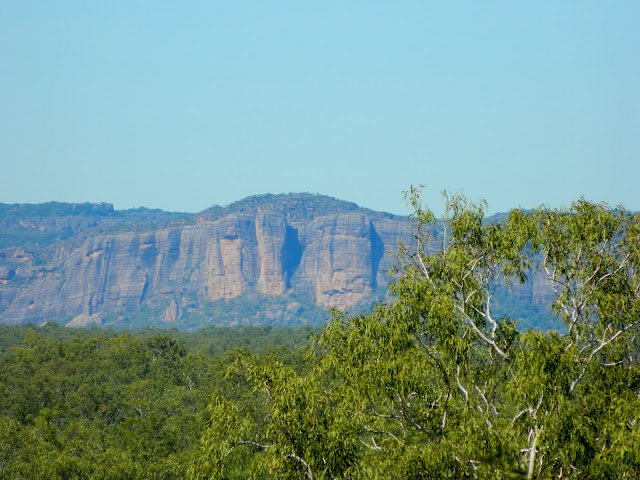Sunday morning we headed out and the first stop was
the Warradjan Aboriginal Cultural Centre, the second of the park’s visitor
centres, where we learnt about the Aboriginal culture and the connection the
Bininj and Mungguy people have with their families and their land. The design
of this building represents the Warradjan, a pig-nosed turtle.
 |
| Six seasonal calendar for the Kakadu region in Gun-djeihmi language |
From here we had a quick look around Gagudju Lodge
at Cooinda before continuing on to Nourlangie Rock.
 |
| Anbangbang Gallery |
On the short walk you come to Gunwarde-warde (don’t
ask me!!) Lookout, from where you have a view across to the Arnhem Land
Escarpment where (legend says) Namarrgon, the Lightning Man, watches for the
first wet season storms.
Also from this lookout, you can take the Baark
sandstone bushwalk, which takes you 12klms all the way around Nourlangie.
Though not as prepared as we could have been, Neil and I decided to hike part
of the walk, while the girls returned to the cars.
The distance we decided to walk wasn’t all that
far, but it was a very steep climb to the top of Burrunggui (see above). As we
took the steep section, we crossed a wet season creek in the small monsoon
forest, climbed around the waterfall (wet season also), before passing through
pockets of sandstone pandanus. At the top, the view across the woodland below was
just magnificent.
Neil and I walked a little further on across the
plateau before returning back the way we came. By the time we got back to the
car park, the girls were beginning to worry… neither Neil or I wear a watch! We
had apparently been gone close to two hours. Sorry Dear!
 |
| Nothing like an open fire in the middle of Kakadu |
 |
| As the sun starts to rise |
 |
| Sleeping croc at daybreak |
 |
| In the still of the early morning |
 |
| And another day breaks |
 |
| Forrest Kingfisher |
 |
| Australian Darter |
 |
| Jesus bird distracting the croc away from her baby (out of picture) |
Any reference to Kakadu, where tourism is
concerned, says a cruise of Yellow Water is a must… I couldn’t agree more, so
put it on your agenda when you come here.
Our cruise fee included a buffet breakfast, which
was served at Gagadju Lodge when we returned to Cooinda. Once we had a belly
full, we returned to our campsite and packed up. Neil and Jan made their own
way to Jabiru and when we caught up with them at the lake, we said our goodbyes
and left them to continue their trip around Kakadu.
 |
| The Cathedral Anthill |
 |
| Us enjoying the day |
Vic and I headed for Darwin and on the way out had
a late lunch at the Bark Hut Inn. On the way home we made another stop, this
time at the ‘Window on the Wetlands’ Visitor Centre, where interactive displays
give you an insight into the ecological processes that occur in the wetlands,
seasonal changes and the problems created by feral animals and weeds. From the
top floor of the building, there is a great view across the lower Adelaide
River floodplain. A visit here is really worthwhile, and the free entry is a
bonus.
Three kilometres down the road is the turnoff to
the Fogg Dam Conservation Reserve, and even though it was getting late, we
decided to have a quick look, while we were close by. The reserve is a haven
for birdlife and is part of the Adelaide River catchment. The dam was built in
the mid 50’s to provide irrigation for the failed Humpty Doo Rice Project.
(That in itself is an interesting story, for another day!) By the time the
project failed, the wetlands had become a dry season refuge for wildlife,
especially waterbirds. It was declared a Bird Protection District in 1959. Our
visit was short due to the fact that a rogue croc is still in the area and you
are advised not to leave your vehicle.
 |
| Another croc trap in Fogg Dam |
We arrived home after dark. Over the weekend we
travelled 1,015 klms and had a fantastic time taking over 700 photos.
Travelling with seasoned Kakadu visitors (Neil & Jan), allowed us to
squeeze a lot into a four-day weekend. I know there is still a lot to see in
Kakadu, and maybe we’ll get back there some other time, but for now I’m
satisfied. It is an incredible place and thoroughly deserving of as much time
as you can give it. Don’t be mislead by those who say it should be ‘Kakadon’t’…
go there and form your own opinion.
When I collected Flash the ‘Wonder Dog’ on Tuesday
morning, she greeted me like a long lost friend… her family is in for a hell of
a reception when they get home!!
Until next week… happy travels. Boh-boh (goodbye).











No comments:
Post a Comment